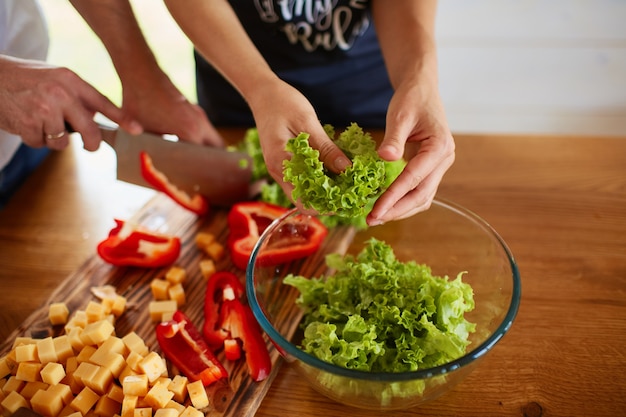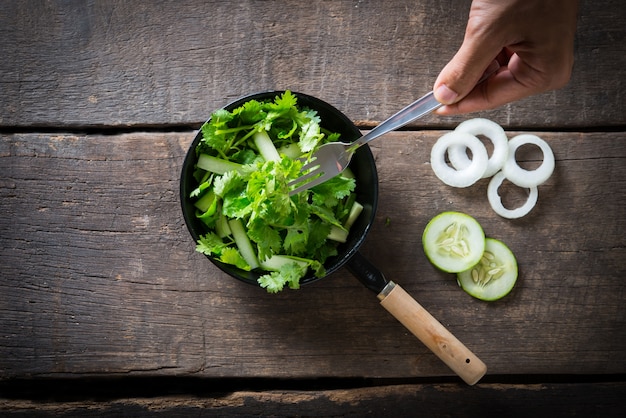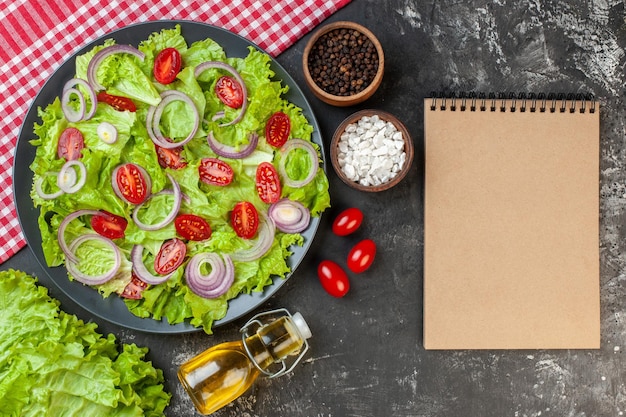We all know lettuce as the leafy star of salads, but have you ever considered cooking it? I know, I know – it seems a bit odd. "Cook lettuce? Why would anyone do that?" you might be thinking. Well, let me tell you, it's a revelation waiting to happen. And no, I'm not talking about turning it into a soggy mess. We're going for something with texture, flavor, and a whole lot of culinary potential.
I've been playing around with cooking lettuce for a while now, and it's opened up a whole new world of possibilities in my kitchen. I've discovered that lettuce isn't just a salad ingredient; it's a versatile culinary tool that can add a unique dimension to your dishes. It's time to ditch the preconceived notions about lettuce and embrace its true potential.
Part 1: The Lettuce Landscape

First things first, let's talk about the different types of lettuce and why they behave differently when cooked. It's not just about tossing any old lettuce into a pan and calling it a day. There's a whole world of lettuce varieties out there, each with its own unique characteristics. And understanding these differences will help you choose the right lettuce for your culinary adventures.
Crispheads
These are the sturdy fellas of the lettuce world, with a firm, crisp texture that makes them perfect for salads. But they also hold up well under heat, making them great for cooked dishes. Think iceberg, butterhead, and cos lettuce.
When cooked, crispheads tend to get tender and slightly sweet. They add a subtle sweetness to stir-fries or even act as a base for vegetarian burgers. For example, I once used a butterhead lettuce as the foundation for a "burger" patty, layering it with black beans, quinoa, and spices. It was surprisingly delicious and satisfying.
Loose-leafs
Loose-leaf lettuce varieties are the delicate dancers of the lettuce family. Think red leaf, green leaf, and baby spinach. They have a more delicate flavour and texture than crispheads and can easily wilt if overcooked. This makes them ideal for quick cooking methods like stir-fries or wilting them into sauces.
I've found that adding a handful of loose-leaf lettuce to a stir-fry towards the end of cooking adds a burst of freshness and a subtle, almost sweet flavor. The gentle heat wilts the leaves slightly, making them soft and palatable without losing their vibrant green color.
Romaine
Romaine lettuce is a bit of a hybrid – it has the firm texture of a crisphead but a slightly more assertive flavour. This versatility makes it suitable for both salads and cooked dishes. My personal favorite way to enjoy romaine is roasted with a drizzle of olive oil and a sprinkle of salt and pepper. It gets deliciously caramelised and slightly crunchy, making it a perfect addition to pasta dishes or as a topping for pizzas.
I remember the first time I roasted romaine. I was skeptical, but the outcome was a revelation. The caramelised edges and the slightly smoky flavor surprised and delighted me. It was a whole new way to experience this humble vegetable.
Part 2: The Culinary Transformation

Now, let's talk techniques. There are several ways to cook lettuce, each with its own unique outcome. From quick stir-fries to slow roasting, there's a cooking method for every lettuce lover.
Stir-frying
Stir-frying is a fantastic way to cook lettuce quickly while retaining its crispness. The high heat and constant movement prevent the leaves from wilting. Chop your lettuce into bite-sized pieces, heat a bit of oil in a wok or large frying pan, and toss it in with your other stir-fry ingredients. It's quick, easy, and adds a vibrant freshness to your dish.
Sautéing
Sautéing is similar to stir-frying but a bit more leisurely. It's perfect for bringing out the sweetness of certain lettuce varieties. Heat a little oil in a pan, add your lettuce, and cook until it's slightly wilted and tender. You can add some garlic, ginger, or onions to give it an extra flavour boost.
One of my favorite sautéed lettuce recipes involves sautéing baby spinach with garlic and a squeeze of lemon juice. The spinach wilts quickly, taking on a vibrant green color and a delightful, slightly tangy flavor. It's a simple but incredibly delicious side dish or topping for a pasta dish.
Roasting
Roasting brings out the natural sweetness of lettuce and adds a wonderful caramelised flavour. Simply drizzle your lettuce with olive oil, season with salt and pepper, and roast in a preheated oven until it's tender and slightly crispy. I love adding a squeeze of lemon juice before serving for a touch of acidity.
I once roasted a whole head of romaine lettuce, halved and sprinkled with a generous amount of olive oil, salt, and pepper. The result was a delicious, caramelised vegetable that was perfect for topping a salad or serving as a side dish. The roasting process brought out a sweetness I hadn't tasted before, and the slight char added a smoky depth to the flavor.
Grilling
Grilling lettuce is a fun and unexpected way to add smoky flavour. Simply brush your lettuce with olive oil and grill for a few minutes until it's slightly charred and tender. This method works best with romaine or sturdy butterhead lettuce.
I remember grilling romaine lettuce for the first time. I was a bit apprehensive, but the result was incredible. The grill marks added a beautiful aesthetic touch, and the smoky flavor enhanced the lettuce's natural sweetness. It was a perfect pairing with grilled chicken and a side of roasted vegetables.
Boiling
Okay, I know what you're thinking – boiling lettuce? That sounds like a culinary crime! But, hear me out. Boiling lettuce is a great way to soften it up for soups or stews. Just add it to your pot of boiling water for a few minutes until it's tender, then remove it with a slotted spoon. It's a great way to add a subtle sweetness and a little bit of texture to your broth.
I used to be skeptical about boiling lettuce, but I was pleasantly surprised by how well it blended into soups and stews. The subtle sweetness of the boiled lettuce added a depth of flavor that I hadn't experienced before. It's a great way to add a touch of green to your broth-based dishes.
Part 3: Recipes and Inspiration

Now that you've got the basics down, let's get into some recipe ideas to inspire your culinary creativity.
Simple Sautéed Lettuce
This recipe is quick, easy, and perfect for a weeknight dinner.
- Heat a tablespoon of olive oil in a large skillet over medium heat.
- Add 1 head of butterhead lettuce, chopped, and cook for 2-3 minutes until wilted and slightly tender.
- Season with salt and pepper to taste.
- Serve immediately.
You can add a touch of garlic, ginger, or chili flakes for a more complex flavor profile. For a more substantial dish, serve the sautéed lettuce with a dollop of Greek yogurt or a drizzle of tahini dressing.
Grilled Lettuce with Lemon Dressing
This is a delicious and easy summer meal.
- Brush romaine lettuce with olive oil and grill for 2-3 minutes per side until slightly charred and tender.
- Whisk together 1/4 cup olive oil, 2 tablespoons lemon juice, and a pinch of salt and pepper.
- Drizzle the dressing over the grilled lettuce and serve immediately.
You can add other grilled vegetables to this dish, like zucchini, bell peppers, or onions. Serve it with grilled chicken or fish for a complete meal.
Lettuce and bean salad
This is a great way to use up leftover cooked lettuce.
- Combine 1 cup cooked lettuce, 1 cup cooked beans (such as kidney beans or chickpeas), 1/2 cup chopped tomatoes, 1/4 cup chopped onion, and a dressing of your choice (such as balsamic vinaigrette or a lemon-tahini dressing).
- Mix well and serve immediately.
This is a versatile salad that you can customize to your liking by adding other vegetables, herbs, or cheese. For a more filling salad, add some quinoa, couscous, or rice.
Part 4: Lettuce in Unexpected Places
Now, let's venture beyond the usual lettuce applications. We're going to explore some truly innovative ways to incorporate lettuce into your culinary repertoire.
Lettuce Wraps
Think beyond your typical lettuce wrap fillings! You can use lettuce leaves to wrap everything from stir-fried vegetables and tofu to pulled chicken and spicy ground meat. Experiment with different flavors and textures to create unique and delicious lettuce wraps.
Lettuce Burgers
This is a great vegetarian alternative to traditional beef burgers. Chop cooked lettuce with some spices, onions, and breadcrumbs to form patties, and pan-fry them until golden brown. It's a delightful twist on a classic.
Lettuce Soup
Don't knock it till you try it! This soup is light, creamy, and surprisingly delicious. Blend cooked lettuce with vegetable broth, coconut milk, and a touch of lime juice for a creamy, flavorful soup that’s perfect for a light lunch or a refreshing dinner.
Lettuce in Desserts
Yes, you read that right. Lettuce can even find its way into your desserts! Certain lettuce varieties, like butterhead, have a subtle sweetness that pairs well with fruits and creamy desserts. Try adding chopped lettuce to a fruit salad, or even incorporate it into a smoothie for a unique flavour twist.
Part 5: The Art of Lettuce Preservation
Okay, so you've bought a whole bunch of lettuce, and you're not sure you'll use it all before it starts to wilt. Fear not, there are ways to preserve your lettuce and keep it fresh for longer.
Storing Lettuce
Store lettuce in a plastic bag in the refrigerator, making sure to remove as much air as possible. It’ll last for about a week this way.
Freezing Lettuce
While freezing lettuce doesn't preserve its texture for salads, it's great for soups, stews, or smoothies. Blanche your lettuce in boiling water for a few minutes, then shock it in ice water. Drain well and freeze in an airtight container.
Pickling Lettuce
Pickling is a fantastic way to preserve lettuce and add a tangy flavour to your dishes. Simply combine your lettuce with vinegar, sugar, and spices, and let it ferment for a few days. This is a delicious and unique way to enjoy lettuce in a whole new way.
Part 6: A Journey of Discovery
Cooking lettuce is a journey of discovery. It's a chance to experiment with different flavors, textures, and culinary techniques. Don't be afraid to be creative and try new things. Who knows, you might just discover your new favorite lettuce dish!
As I've explored the world of cooked lettuce, I've found that it's a blank canvas for culinary creativity. The possibilities are endless, and the journey is as exciting as the destination.
Part 7: Beyond the Salad Bowl
As I've continued to explore the world of cooked lettuce, I’ve found myself using it more and more in unexpected ways. I've started incorporating it into my regular cooking routine, adding it to everything from stir-fries to tacos to curries. And the best part? It's always a conversation starter. People are often surprised by the flavour and texture of cooked lettuce, and it's always fun to watch their faces light up when they realise how versatile and delicious this humble green can be.
I've learned that cooked lettuce can add a subtle sweetness and a delicate texture to dishes, making it a welcome addition to a wide range of culinary creations. It's a reminder that sometimes the simplest ingredients can yield the most surprising and delicious results.
Part 8: Lettuce and Health
Besides being a delicious addition to your diet, cooked lettuce is also packed with nutrients. It's a good source of vitamins A, C, and K, as well as folate and potassium. Cooking lettuce helps to soften the tough fibers, making it easier to digest.
So, not only is cooking lettuce a culinary adventure, but it's also a healthy way to enjoy this versatile vegetable.
Part 9: The Final Word
So, there you have it. Cooking lettuce isn’t just for adventurous cooks – it’s a chance to add a unique flavour and texture to your dishes while adding valuable nutrients to your meals. Whether you're a seasoned chef or a kitchen novice, I encourage you to give it a try. You might just surprise yourself.
I hope this article has inspired you to experiment with cooking lettuce! It’s a versatile ingredient that can add a lot of flavor and texture to your dishes. So, go forth and cook some lettuce! And let me know what you discover!
FAQs
1. What is the best type of lettuce for cooking?
Sturdy lettuce varieties like crispheads (e.g., iceberg, butterhead) and romaine are best for cooking. They hold up well under heat and develop a lovely tenderness and sweetness. Loose-leaf varieties can also be used for quick cooking methods like stir-frying or wilting them into sauces.
2. Should I wash lettuce before cooking it?
Yes, it's always best to wash lettuce thoroughly before cooking, just like you would for a salad. Rinse it under cold water and shake off any excess water before using it. This will ensure your lettuce is clean and free of any dirt or debris.
3. Can I cook lettuce in advance?
Yes, you can cook lettuce in advance and reheat it later. It's best to reheat it gently over low heat or in the microwave to avoid wilting. Cooked lettuce can be stored in an airtight container in the refrigerator for up to 3 days.
4. Can I use cooked lettuce in salads?
While cooked lettuce won’t have the same crisp texture as raw lettuce, it can still be used in salads. It adds a different dimension of flavor and texture, so experiment to find what you like best. For example, you could use cooked romaine lettuce as a base for a salad and top it with grilled chicken, chickpeas, and a lemon vinaigrette.
5. What are some tips for cooking lettuce?
Here are a few tips for cooking lettuce successfully:
- Use a high heat for stir-frying or sautéing to prevent the lettuce from becoming soggy.
- Don't overcook lettuce. It should be tender but still have some bite.
- Season generously with salt and pepper to bring out the flavor.
- Add other vegetables, herbs, or spices to create more complex flavor profiles.
- Be creative and don't be afraid to experiment. Lettuce is a versatile ingredient that can be used in a wide range of dishes. So, get creative and have fun in the kitchen!
I hope this article has inspired you to experiment with cooking lettuce! It’s a versatile ingredient that can add a lot of flavor and texture to your dishes. So, go forth and cook some lettuce! And let me know what you discover!
Everyone is watching

How to Cook Frozen Lobster Tails Perfectly: A Step-by-Step Guide
RecipesLobster. Just the word conjures up images of lavish meals, special occasions, and a taste of luxury. But let's...

Pigs in a Blanket Cooking Time: How Long to Bake for Perfect Results
RecipesAh, pigs in a blanket. Just the name conjures up images of those delightful little parcels of crispy pastry en...

Pork Fillet Cooking Time: How Long to Cook It Perfectly
RecipesPork fillet, or tenderloin as it's sometimes called, is a real favourite in our house. It's so versatile, and...

The Ultimate Guide to Tender, Juicy Pulled Pork
RecipesRight, let's talk pulled pork. It's one of those dishes that just screams "comfort food," doesn't it? I mean...

The Ultimate Guide to Cooking Sweet Potatoes: From Roasting to Mashing
RecipesSweet potatoes. Just the name conjures up images of warm, comforting dishes, bursts of vibrant color, and a to...
